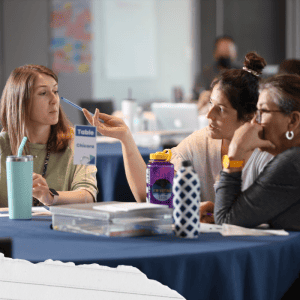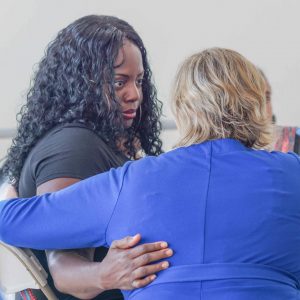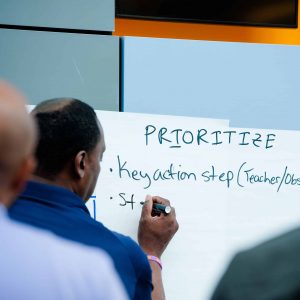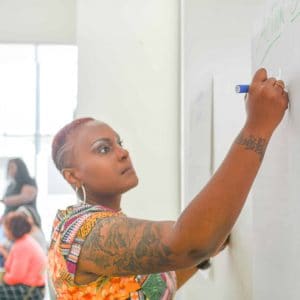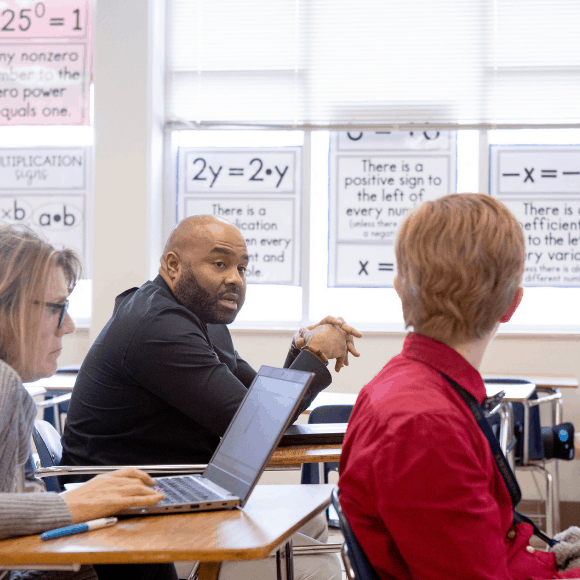
Putting Professional Learning Models to Work
11/19/2020

An Excerpt From “The Elements”
This essay is an excerpt from The Elements: Transforming Teaching through Curriculum-Based Professional Learning, a challenge paper that explores how professional learning anchored in high-quality curriculum materials allows teachers to experience the instruction their students will receive and change their instructional practices, leading to better student outcomes. Cowritten with Stephanie Hirsh, former executive director of Learning Forward, and featuring lessons learned through the work of Carnegie Corporation of New York grantees, The Elements provides essential guidance for transforming teaching and student learning.
Models
While professional development is often one-size-fits-all — think mandatory schoolwide seminars or universally assigned courses — the format and content of curriculum-based professional learning evolve over time. They are necessarily informed by the needs and goals of individual teachers as they progress through different stages of learning.
Curriculum-based professional learning includes multiple models of learning and provides teachers with different types of learning experiences. These run the gamut from early exposure to expert refinement — individual investigations, coaching, expert support, professional learning communities, study groups, institutes, workshops, and classroom observations.
This approach to professional learning respects teachers as individuals with different needs and levels of experience. It involves three stages of curriculum implementation, with learning experiences tailored to teachers based on their focus area, such as their grade or subject, and how long they have been working with the curriculum materials. Just as students need different types of lessons at different moments of study, teachers benefit from professional learning that matches their levels of knowledge and experience.
The impact of the LEAP model can be traced to three major factors: high-quality instructional materials and curriculum-based professional learning, a broad commitment and the structures in place to commit time and energy to professional learning, and a culture of collaboration and social accountability for improvement.”
Curriculum-based professional learning often starts with a curriculum’s launch: selecting and introducing high-quality instructional materials in an intensive summer institute or workshop, for example. In this initial use stage of learning, an immersion model is essential. Rather than simply discussing the curriculum, teachers immerse themselves in lessons just as students would, participate in reflective conversations, and plan for the lessons’ use in their classrooms. Classroom observations, videos of the instructional materials implemented in other schools, and insights from other users can give teachers a sense of what to anticipate for their students.
Once teachers move into the day-to-day use of the curriculum, they enter the ongoing support stage. Seminars and presentations are less valuable at this stage; instead, facilitated professional learning communities can build curricular expertise and a collegial culture. Teachers can examine student work and data together, visit one another’s classrooms in learning walks, and reflect on their experiences. Mentoring and coaching can provide just-in-time feedback to strengthen instructional practice as they incorporate new materials into their classrooms.
In the building capacity stage, leaders take the long view at the systems level. They anticipate turnover; develop talent pipelines for coaching, principal, and teacher leader roles; and establish networks of experienced educators to ensure professional learning and support continue. Models such as study groups help teachers refine and adapt instructional materials, and leadership academies and advanced certification programs build a leadership pipeline.
No single experience can achieve every target outcome in every phase. To put teachers in cohorts without first engaging them in an immersive learning experience, for example, would be to bypass an important stage of learning that informs the implementation of future units and lessons. Similarly, minimal benefits can be gained from taking a learning walk through a classroom before a teacher has developed an understanding of how lessons should proceed or worked with an expert coach to define an improvement goal. Choosing wisely among models can accelerate teacher development and student success.
Putting Models to Work
This approach to models represents three major shifts from the way most professional development occurs:
- A tailored approach: Professional learning is not one-size-fits-all. It should include a collection of research-based learning approaches that instructional leaders thoughtfully select based on the needs of individual teachers and professional learning communities at different stages of implementation.
- Consistent effort: Summer institutes are the beginning, not the end. Curriculum-based professional learning continues throughout the school year and takes different forms, including professional learning communities and instructional coaching.
- Looking forward: Curriculum-based professional learning must be ongoing and sustainable, which means it cannot be led solely by outside experts. Schools and districts must plan for the future by building in-house expertise and leadership pipelines.
Models and Time in Action: District of Columbia Public Schools and Leading Educators
Every week, teachers meet with their colleagues for in-depth curriculum study, practice, and planning at District of Columbia Public Schools. Each team is carefully composed by subject and grade band. Facilitated by a well-prepared instructional leader, teachers review student data and progress, rehearse lessons, and reflect on recent classes as they plan ahead.
These sessions are part of the LEAP program, short for Learning Together to Advance our Practice, which D.C. schools launched with Leading Educators in 2016. LEAP is used in all 116 of the district’s public schools, where student proficiency on annual tests has increased by 15 percent in reading and 11.5 percent in math in four years.
“Prior to LEAP, in my experience, teachers who received in-house coaching were teachers who were struggling. And there was this idea that teachers who were really strong or who were really doing well in the classroom didn’t need the support,” said Libby Sanchez, a teacher leader at Marie Reed Elementary School. “So, one thing I appreciate now is … there’s this recognition that all teachers deserve an opportunity to grow, and they need and deserve an opportunity to get better in their practice.”
LEAP’s laser focus on high-quality instructional materials, such as those from the Eureka Math curriculum the district has adopted, sets it apart from other teacher development efforts. It is school-based and specific to the content that teachers and their students are grappling with at a particular moment. Teaching teams follow a sequence of adult learning content that lines up with the classroom curriculum.
Over a three-week cycle, teachers and coaches meet in professional learning communities, where they review lessons in detail and select a relevant instructional skill to focus on. Teachers then plan a lesson from the curriculum materials that draws on that skill and practice it with their students. They reflect with their colleagues and experience frequent observations — more than 30 each school year — to get the feedback they need to refine and improve their instruction. Ongoing conversations stress the importance of building students’ academic skills and sophistication for success now and later.
The program’s keystone is its 600 LEAP leaders, who serve as instructional leaders and coaches at their schools as part of the district’s Teacher Leadership Initiative. About 600 teacher leaders participated in a two-week summer institute at the program’s launch. For seven days each school year, they attend districtwide professional learning sessions to analyze implementation data, refine their instructional leadership and coaching skills, and address challenges. These teacher leaders guide well-planned learning activities that shift throughout the year, responding to different needs and building different capacities as teachers learn and grow.
According to Chong-Hao Fu, chief executive officer at Leading Educators, “The impact of this model can be traced to three major factors: high-quality instructional materials and curriculum-based professional learning, a broad commitment and the structures in place to commit time and energy to professional learning, and a culture of collaboration and social accountability for improvement.”
“We know that quality matters dramatically in terms of whether teacher learning will yield positive cultural benefits as well as increased student learning,” he said. “DCPS adopted high-quality instructional materials, and almost all of the work was curriculum-specific, which meant that teacher learning was anchored in what student learning would be. And that also gave the opportunity for teachers to understand the design principles and learning science behind a strong curriculum.”



